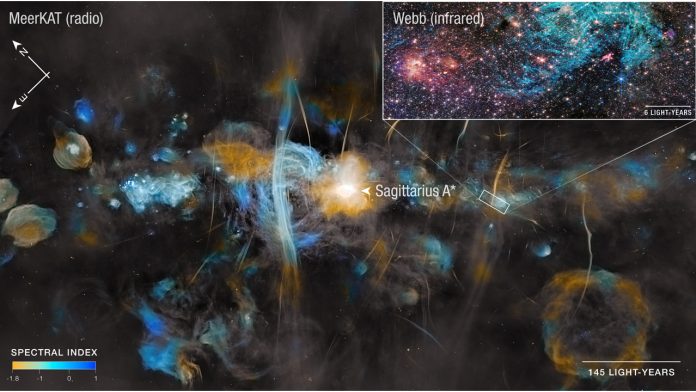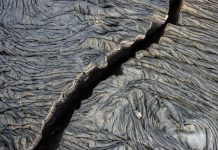
New James Webb Space Telescope (JWST) research unveils the surprising influence of strong magnetic fields on star formation within the Milky Way’s central region, Sagittarius C, offering crucial insights into why fewer stars are born there than expected
New observations from NASA’s James Webb Space Telescope are providing unprecedented insights into the enigmatic process of star formation within the Milky Way’s central star-forming region, Sagittarius C. Despite abundant raw materials, this area near the galaxy’s supermassive black hole, Sagittarius A*, exhibits a surprisingly low star formation rate, puzzling astronomers for decades.
Two groundbreaking studies utilising Webb’s powerful infrared capabilities have now shed light on a potential culprit: strong magnetic fields that appear to be actively hindering the birth of new stars.
These findings, detailed in two papers published in The Astrophysical Journal, leverage Webb’s ability to peer through the dense clouds of gas and dust that typically obscure stellar nurseries.
The research reveals not only the presence of massive, actively forming protostars and their powerful outflows but also compelling evidence suggesting that intense magnetic fields are shaping the very structure of the region and suppressing the gravitational collapse necessary for star birth. This research marks a significant step forward in understanding the complex interplay of forces that govern the life cycle of stars, particularly in extreme galactic environments.
Unveiling protostars and their energetic outbursts
One of the key achievements of the Webb observations was the confirmation and detailed analysis of protostars within Sagittarius C’s brightest cluster. Building upon previous findings from the Atacama Large Millimeter Array (ALMA), the Webb data, combined with observations from retired infrared telescopes like Spitzer and SOFIA, and the Herschel Space Observatory, definitively identified two massive protostars, each already exceeding 20 times the mass of our Sun. Crucially, Webb’s sensitive infrared instruments captured the bright outflows, or jets of material, being ejected from these nascent giants.
Furthermore, the team successfully identified five promising candidates for low-mass protostars, which are typically much harder to detect as they remain deeply embedded within their dusty cocoons. By comparing Webb’s infrared data with past ALMA observations, researchers were able to pinpoint these emerging stars.
The analysis also revealed 88 distinct features indicative of shocked hydrogen gas, where the high-speed jets from young stars collide with the surrounding gas cloud. This led to the discovery of a previously unknown star-forming cloud within the Sagittarius C region, hosting at least two protostars actively powering their own jets.
“Outflows from forming stars in Sagittarius C have been hinted at in past observations, but this is the first time we’ve been able to confirm them in infrared light,” explained Samuel Crowe, a principal investigator on the research and a senior undergraduate at the University of Virginia. “It’s very exciting to see, because there is still a lot we don’t know about star formation, especially in the Central Molecular Zone, and it’s so important to how the universe works.”
Magnetic fields: The unseen sculptors and star formation inhibitors
The second study focused on the striking filamentary structures observed in Webb’s 2023 image of Sagittarius C, which depicted hot hydrogen plasma surrounding the main star-forming cloud. New analysis led by astrophysicist John Bally of the University of Colorado Boulder suggests that these distinctive filaments are sculpted by the region’s powerful magnetic fields. These fields have been previously detected by ground-based observatories like ALMA and MeerKAT.
The researchers hypothesise that the extreme tidal forces exerted by the Milky Way’s supermassive black hole, Sagittarius A*, are responsible for stretching and amplifying the surrounding magnetic fields. These intensified fields, in turn, appear to be shaping the hot plasma into the concentrated filaments observed by Webb.
More significantly, the team proposes that these strong magnetic fields may be the key to Sagittarius C’s unexpectedly low star formation rate. The magnetic forces could be strong enough to counteract gravity, preventing the dense clouds of gas and dust from collapsing under their own weight and initiating the process of star birth.
“A big question in the Central Molecular Zone of our galaxy has been, if there is so much dense gas and cosmic dust here, and we know that stars form in such clouds, why are so few stars born here?” said Bally. “Now, for the first time, we are seeing directly that strong magnetic fields may play an important role in suppressing star formation, even at small scales.”
Implications for understanding galactic evolution
These new findings from the James Webb Space Telescope highlight the crucial role that magnetic fields may play in the ecology of star formation, particularly in the dynamic and extreme environment of the galactic center. The ability of Webb’s infrared instruments to penetrate the dusty veil of Sagittarius C has opened a new window into understanding the complex interplay of gravity, turbulence, and magnetic forces that govern the birth of stars.
“This is an exciting area for future research, as the influence of strong magnetic fields, in the center of our galaxy or other galaxies, on stellar ecology has not been fully considered,” noted Crowe. As Webb continues its mission, astronomers anticipate further observations of Sagittarius C and other star-forming regions, promising to unravel more of the mysteries surrounding the birth of stars and the evolution of galaxies across the cosmos.










